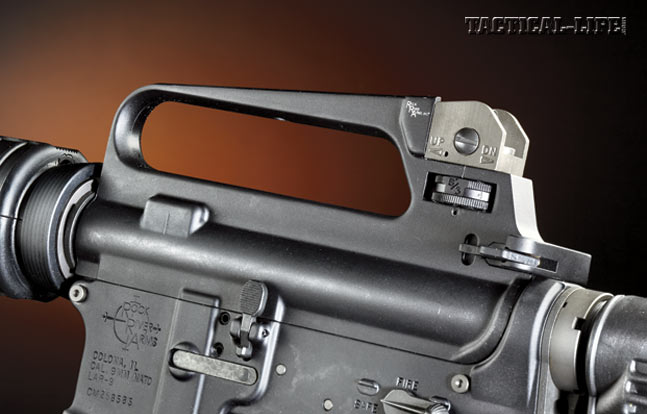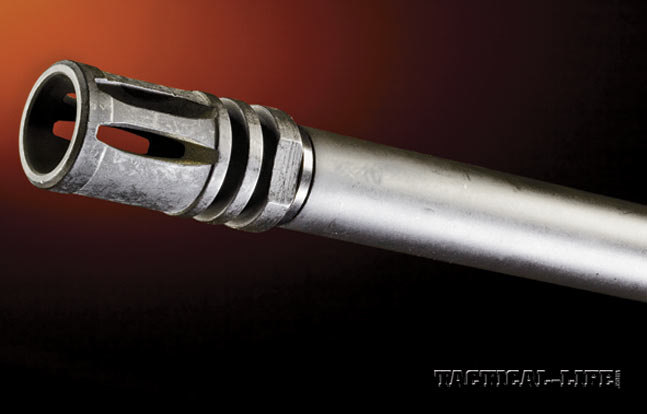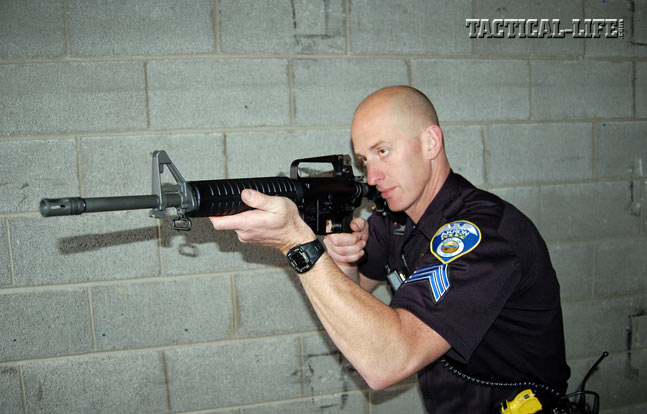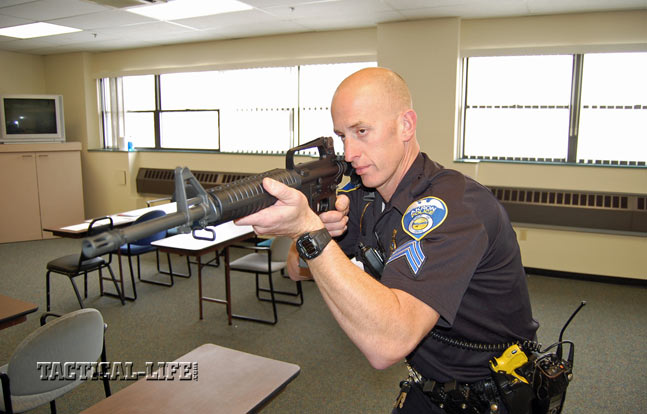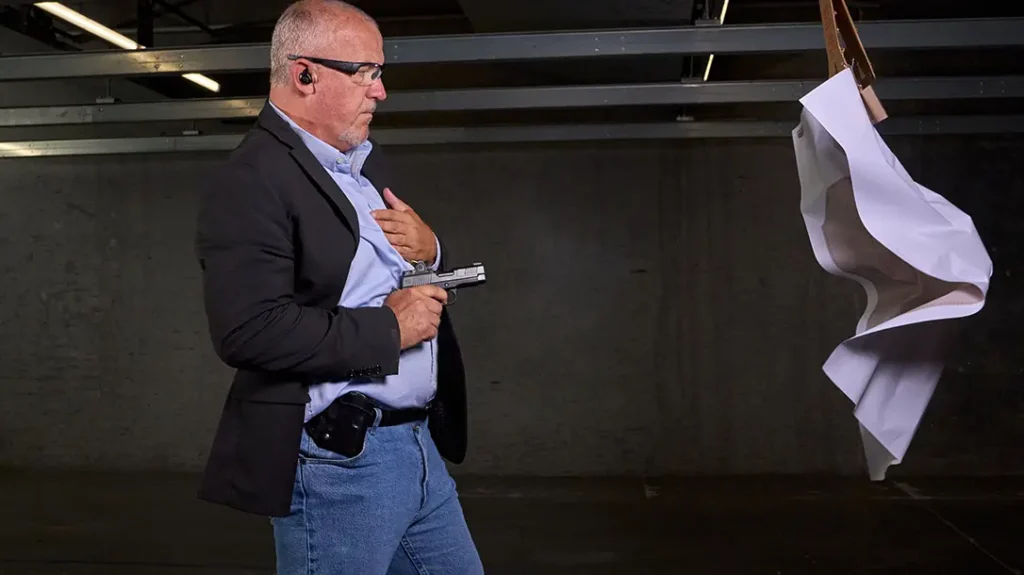Just a casual perusal of a law enforcement ammunition supplier in my state found the following: 200 rounds of Winchester 55-grain, soft-tip, .223 ammo cost $179, while 500 rounds of Winchester 115-grain 9mm cost around $160. Let’s extrapolate that to 1,000 rounds, a decent number for a basic three-day LE carbine operator program. The .223 Remington ammo would cost $895 for 1,000 rounds, while the 9mm would only cost $320. In other words, during a training phase, an officer could fire three times as many 9mm rounds than .223, and that’s a lot more training.
Now, I am not against training with 5.56mm/.223 rounds as much as possible, but a question arises in these cash-strapped days: If it comes down to training or not training, or limiting the rounds fired, can we learn and substitute a 9mm carbine based on the AR platform for the larger rifle rounds? Does it translate to shooting the 5.56mm/.223? The short answer is yes, and the Rock River Arms (RRA) LAR-9 is up to the task.
I recently received a 9mm LAR-9 carbine for testing. I’ve tested other RRA carbines before, and the company even built one for me based on what it believed a modern patrol carbine should include. I’ve been to the factory and met the fine folks at RRA, so I have no question that their products are top of the line. But the question was, in this day and age of availability and cost of 5.56mm NATO ammunition for law enforcement, would a 9mm carbine substitute in initial learning and training stages? I mean, we all know of .22 uppers that can be used, but trying to find .22 ammunition is actually harder at this stage than centerfire pistol ammo. There is also the question of proper training in regards to the .22’s accuracy out to 50 yards.
Advertisement — Continue Reading Below
A quick call to Doug Vance of Vance’s Law Enforcement in Columbus, Ohio, confirmed my suspicions. Doug had 9mm and 5.56mm on hand for purchase, but a quantity of, say, 50,000 rounds drop-shipped directly to an agency from the manufacturer would have a six- to nine-month delay. Obtaining .22 ammunition would take even longer, with a nine-month to one-year delivery delay. Doug gave some rough prices on ammo prices: 1,000 rounds of 115-grain 9mm and 55-grain 5.56mm training ammunition would cost $260 and $400, respectively. At my quoted 50,000 rounds, the price difference between the two is $7,000. As I stated earlier at a casual glance, now confirmed with some hard numbers based on a 50,000 round purchase, training with 9mm ammo instead of 5.56mm means roughly 27,000 more rounds to fire at the same price.

LAR-9’s 9mm chambering. Note the shortened ejection port and rounded shell deflector.
Gun Details
Taking a look at the LAR-9 A2, it appears in size and weight to be no different than a 5.56mm carbine from RRA. Indeed, checking comparable RRA carbines, the 9mm LAR-9 Mid-Length A4 carbine weighs in at 7.1 pounds and has an overall length of 36 inches, while the 5.56mm LAR-15 Mid-Length A4 weighs the same and is as long.
Advertisement — Continue Reading Below
The LAR-9 A2 I tested came with a fixed carry handle/rear sight as well as a fixed A2 front sight base. The fit, finish, look and feel—as well as the sights and controls—were all the same as a standard 5.56mm carbine. The LAR-9 also came from RRA with a 32-round, double-stack magazine. It features a straight-blowback system of operation.
RRA offers several variants of the LAR-9, including flattop carbines like the CAR A4. Customers can also customize their LAR-9 with various buttstocks, handguards, pistol grips, triggerguards, muzzle brakes, safety selectors, gas blocks and front sights. You can easily recreate the style of patrol rifle that you or your agency fields on the street in 9mm by getting whatever rifle setup (red dots, white lights, slings) you field and putting the exact same accessories on the LAR-9. Or you or the department can purchase an iron-sighted carbine in 9mm to learn the fundamentals in basic carbine training and then transition to the 5.56mm. The 9mm could be used for the bulk of the training program, and then you can transition to the .223 version for agency or state qualifications.

Tactical teams can issue or have 9mm LAR-9 carbines available for the same training rationale as well as have duplicate carbines set up for warrant service. After all, although the penetration of the 5.56mm is not an issue, muzzle blast and noise inside a house or small room are. Certainly the 16-inch barrel of the LAR-9 increases the bullet performance and range of 9mm duty ammunition. My tactical team had several shootings with 9mm submachine guns back in the day that stopped a few bad guys right in their tracks.
Advertisement — Continue Reading Below
Having a pistol-caliber carbine capable of being kitted out the same as its rifle-caliber brother makes a tremendous amount of sense. The 9mm carbine as an entry weapon still has its place with the M4, or in this case the A2, version having the added benefit of coming in a platform that is familiar to most officers or operators. Having all the controls in the same location, as well as the same weight and feel, improves handling performance.

Range Time
Out to 50 yards, I treated this carbine just like I would a similar 5.56mm model. I also conducted all of my usual drills with the LAR-9, including moving aggressively off the “X,” pivoting 90 and 180 degrees, shooting from standing, kneeling and prone, and shooting on the move in search, raid and hostage-rescue speeds. I did not experience one malfunction or failure to fire in the testing cycle. The toughest part of shooting the LAR-9 was loading the single 32-round magazine that came with the carbine.
Advertisement — Continue Reading Below
This was a “plain Jane” A2 carbine, but it would suffice to learn to run the gun and practice the fundamentals: platform, grip, sight alignment, sight picture, trigger management, breathing, follow-through and recovery. The trigger felt similar to a 5.56mm RRA carbine’s. The LAR-9’s recoil, in regards to a 5.56mm’s, was a non-issue. There is virtually no recoil for a 5.56mm in the first place, and the 7.1-pound weight of the LAR-9 A2 ensures there is almost no recoil impulse from firing 9mm handgun cartridges.
Could I have substituted the 9mm for a 5.56mm carbine in a three-day basic carbine operator course or a five-day instructor program? Yes, although I didn’t shoot out to 100 yards in this cycle. Truthfully, I’ve found few police ranges that even allow 100-yard distances to be attained, and mine is no different. Ammunition expenditure is certainly an issue, as many agencies are unable to budget for the 1,000 to 1,200 rounds a standard three- or five-day program requires.

LAR-9’s magazine well to accept straight, double-stack, 32-round magazines.
The LAR-9’s accuracy was a very pleasant surprise. Firing from a modified bench, I was able to shoot some solid five-shot groups. Remington’s excellent 147-grain Golden Saber Bonded JHP fodder created the best group, with four rounds clustering into a half-inch and the fifth round only a short distance away for a group size of about 1.25 inches. Black Hills’ 124-grain, standard-pressure JHP ammo created a best group measuring 1.5 inches, as did the company’s JHP +P ammo.
Advertisement — Continue Reading Below
As a side note while on the range, the 9mm allowed me to segue to training on metal targets, such as the 8-inch round pistol target from Challenge Targets, at 30 feet versus the recommended distance of 100 yards with 5.56mm. Lest you think that you can shoot steel with 5.56mm FMJs inside of 100 yards, I will tell you about a friend and very accomplished shooter who was hit with a bullet tip from a metal target he shot inside 50 yards. Had the fragment hit an unprotected eye, he would have sustained a permanent injury rather than having the fragment cut out by his doctor.

Final Thoughts
Well, we started with the question of whether or not the Rock River Arms LAR-9 could be used to learn the basics of carbine weapon manipulation and firing. That was proven to be true with the first magazine of 9mm rounds fired downrange. From then on I found that the LAR-9 had a role as an entry carbine. Sure, the LAR-15 and M4-type rifles in 5.56mm are sexy, but in today’s law enforcement we have limited budgets for ammunition and limited time for training. Additionally, if you’ve never experienced a carbine, rifle or shotgun going off in a small room, the muzzle blast and noise of a 5.56mm is a lot different than the pistol-caliber 9mm cartridge.
Advertisement — Continue Reading Below
Will the LAR-9 replace the LAR-15? Of course not, but it does have a role and a place, and it is a quality weapon system capable of delivering fight-stopping, accurate fire in a chambering that is more economical. And yes, money does not grow on trees, as the people with their hands on the purse strings often remind us, but with some creative engineering and a LAR-9, we can get more bang for our buck. The LAR-9 from Rock River Arms is worth your or your agency’s investment, and that’s the bottom line.
For more information, visit http://www.rockriverarms.com.



